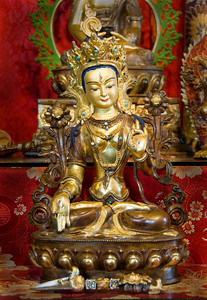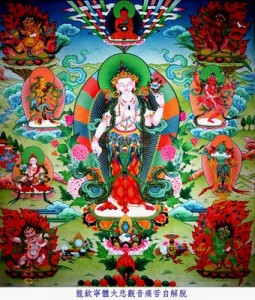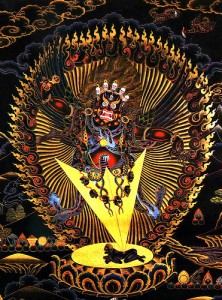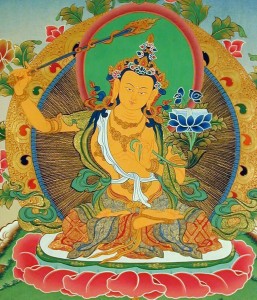An excerpt from a teaching called Compassion, Love, & Wisdom by Jetsunma Ahkon Lhamo
One of the techniques commonly practiced on the Vajrayana path is generating oneself as the Deity. When generating as the Deity one actually arises in a pure form, a form that is free of desire, a pure and fully enlightened form. Through mantra and visualization and recitation you allow yourself to arise naturally in a form that is an enlightened form and is considered a form of the Buddha. Arising in that pure state the mind is free of all the impurities such as desire and conceptualization and of the things that it does, and all perception is then seen as pure as well. We visualize the perception in a pure way and come to understand that the perception we have is innately pure. From that a natural purification takes place.
Many techniques are used and the result of these techniques is the wisdom we seek, not the techniques themselves. We are not collecting techniques. We are not collecting empowerments, we are not collecting things. That is not the wisdom. The wisdom we seek is the result of the pacification of constantly arising desire within the mindstream. It is the pacification of the mind expressing itself in an impure form. It is the pacification of the results that we constantly experience of erroneous belief. That is pure wisdom. Having obtained that wisdom one is actually liberated from cyclic death and rebirth. How is that?
Well, we have this idea about what happens. You collect all this wisdom and then some guy shows up. It’s probably going to be a guy, because guys are big this year. This guy shows up and is probably going to wear white. Don’t you think that white is good? I mean in this culture we think about white a lot so he is going to wear white. He is going to show up and he is going to say you have accumulated enough wisdom and now you are – sounds like Bill Cosby doesn’t it – and now you are fully enlightened. I bet it is Bill Cosby. So now you are fully enlightened and having been fully enlightened then I am going to take from you the need – now I am beginning to sound like an evangelist – now I am going to take from you the need to reincarnate in some future existence. We have some kind of dream that something like that is going to happen: we will be anointed and we will have stars on our crown and all this kind of thing. According to the Buddha’s teaching that is not what is going to happen. I am sorry. The Hallelujah chorus is a beautiful piece of music, but they are not going to play it when your moment comes, so don’t be waiting for a sign like that.
When we talk about the kind of wisdom that is necessary to accomplish the awakening that is so treasured and so desired, we talk about the elimination and pacification of all things that produce the causes of cyclic existence. The Buddha says that we actually take rebirth in a compulsive way and that compulsion is based on desire. When that desire is eliminated and pacified because the nature, the true nature, is understood and the belief in self as being inherently real is done away with, that very cause for us to take rebirth in this compulsive way is gone. There is no necessity to take rebirth. However, the Vajrayana path contains all of the Mahayana hopes and ideals; we achieve a state of realization that is ultimately of benefit to all sentient beings, not only ourselves. Having achieved that stability of mind, the realization of the natural state through practice, having poised ourselves on that pristine moment of pure cognition, that which is called innate wakefulness and yet has within it no conceptualization, we then can choose to return again and again and again in an emanation form in order to be of benefit to sentient beings.
© Jetsunma Ahkön Lhamo


![DSC_4465-940-glass-of-tap-water[1]](https://www.tibetanbuddhistaltar.org/wp-content/uploads/2010/09/DSC_4465-940-glass-of-tap-water1-300x225.jpg)

